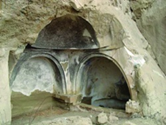Dodo Church
Dodo Church, Small Church of St. Dodo, first half of 6th century
Dodo Church was a center of education and culture in medieval Georgia. It is an important monument of Georgian architecture in the David Gareji monastery complex.
It was founded in the first half of the 6th century by Dodo, one of the disciples of David of Gareji. It consists of a complex of caves dating from the 6th to 18th centuries.
The main hall church and the refectory date back to the 11th–13th centuries. The small church of St. Dodo is especially noteworthy. The conch of the altar's apse, the dome carved into the rock, the northern wall and part of the wall of the western narthex have been preserved there. One of the earliest (8th–9th centuries) and important examples of painting in Georgia has been preserved in the conch. It displays the blessing of Jesus, who is holding an open book with traces of a Georgian inscription in his left hand. There is a medallion on both sides of Jesus. One depicts a female figure with a moon above her head, the other — a young man in a Phrygian cap holding a flaming torch in his right hand. It seems that the first figure represented the moon, and the second one — the sun. Such images are found in the early Christian sarcophaguses. The archangels Michael and Gabriel, as well as a tetramorph (symbolic image of the four evangelists) and a cherub are portrayed below Jesus.
The history of the Dodo Church is connected with the history of the David Gareji Monastery. In the 12th–15th centuries, Dodo Church was a royal monastery. In 1424, Alexander I donated it, along with David Gareji Monastery, to the Svetitskhoveli Cathedral, and from the 15th to the 17th centuries it was subordinate to the Catholicos-Patriarch, and then, until 1760, to the Bishop of Ninotsminda. In the 13th–18th centuries, Dodo Church was repeatedly abandoned as a result of invasions (Mongols, Tamerlane, Turks, Iranians and Lezgins). The situation improved from the end of the 17th century, but due to frequent Lekianoba (attacks by Lezgins), it was again deserted. In 1760, Dodo Church was transferred to David Gareji Monastery.
The monastery is currently open to visitors.
Literature: ლ ო მ ი ნ ა ძ ე ბ., ქართული ფეოდალური ურთიერთობის ისტორიიდან (სენიორიები), [ტ.] 1, თბ., 1966; В о л ь с к а я А., Росписи пещерных монастырей Давида-Гареджи, კრ.: კახეთის არქეოლოგიური ექსპედიციის შრომები, ტ. 8, თბ., 1988.
B. Lominadze
T. Sakvarelidze


